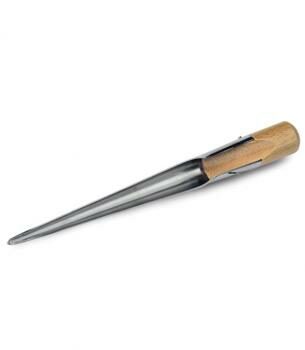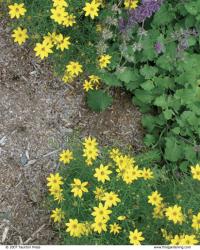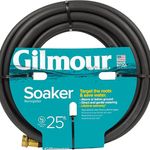Weeding Made Easy
These hand tools may look strange, but they’re designed to get the job done right

Of all the garden chores, hand weeding—yanking weeds while bending, squatting, or kneeling—is the most onerous. It is such a miserable job that the California legislature has banned farmers from requiring it of their workers.
Fortunately, most of us don’t have to endure endless days stooping beneath a sizzling California sun. But we do have weeds that require removal by hand. I know gardeners with considerable strength, skin like leather, and the pain threshold of a pit bull who take great pride in weeding by hand. They are not, however, afflicted with arthritis, sciatica, or the dreaded “unspecified neuropathy” that physicians refer to when the rest of us hobble into their offices seeking pain relief after a day of vigorous weeding. We, the ungifted ones, need tools that take the toil out of weeding, giving us more time to enjoy the garden.
Options abound for the gardener seeking an easier way to weed. The files of the U.S. Patent Office must contain six trillion designs for weeding tools. Hundreds of those designs are on the market at any one time. Some are absurd and useless. Most are indifferently useful. A few are remarkable in their effectiveness. Here are five from the last category.
The Garden Bandit weeds near plants without harming them
 |
 |
One reason why weeds are such a nuisance is that they are smart. They somehow know to sprout right next to one of our desirable seedlings because we’re afraid that pulling the weed out will damage the plant we want. The weed is then free to take up the water and nutrients we intend for our seedling.
It’s taken a while, but we’ve finally outsmarted these weeds. The Garden Bandit consists of a thin, narrow loop of stainless steel attached to a thick, plastic paddle. The 5-inch-long by 2-inch-wide loop slides easily beneath the soil to decapitate weeds, and can slice deeply if the soil is moist. The best aspect of the looped blade is that its tip can work close to the base of tender young plants without severing their roots. Most slicing weeders must be kept well away from desirable seedlings for fear of causing fatal root damage. A loop or circle, in its very geometry, matches the downward and outward growth of a plant’s roots and the upward and outward growth of its stem and branches. The Garden Bandit eliminates a lot of the thumb and forefinger weed pulling usually necessary around seedlings.
Source: LeeValley.com
The fulcrum weeder relies on leverage to extract weeds
 |
 |
As an all-purpose tool that excels at prying out weeds with fibrous roots or taproots, the fulcrum weeder has yet to be surpassed. Also known as a ball weeder, this tool has a two-pronged fork at its business end. Just above the fork is either a round, steel strap or a wooden ball. The tines of the fork are set at an acute angle, forming a deep, narrow V. Shove the tines almost vertically into the soil at the base of a weed, and push the handle toward the ground. The steel strap serves as a fulcrum, allowing leverage to pop the weed from the ground without straining the wrist.
Avoid weeders that rely on leverage from a narrow or V-shaped strap. When the soil is soft or wet, the strap pushes into the soil and provides no leverage. Fulcrum weeders with a round, metal strap more than an inch wide have enough surface area to avoid this problem. Models that use a wooden ball as a fulcrum do the job in all but the wettest soil, but they can be difficult to find.
This product is no longer available. Consider instead the Corona CT3750 eGrip Weeder. Source: Amazon.com.
The Fid reaches deep to get out taproots
 |
 |
Weeds that store energy in underground bodies (taproots, corms, and bulbs, for example) are especially difficult to eradicate. If you cut them off at the surface, they will grow a new set of leaves. If you don’t remove the underground energy supply, you’ll have to do some timely and repeated weeding until you exhaust the plant’s reserves.
The Fid, a tool consisting of a tapered trough of stainless steel protruding from a hardwood handle, excels at removing plants with taproots, such as dandelion and Queen Anne’s lace. It also works well with nut grass and other weeds with buried tubers and corms. This precise tool works in tight plantings where a ball weeder would damage adjacent plants. Hold the tool vertically, and push it straight down alongside the main taproot. Then pull or pry out the weed.
We haven’t been able to locate a source for The Fid. Check garage sales for this item. Lee Valley Tools sells a comparable tool, the All-Purpose Lifetime Weeder.
Get weeds before they sprout
 |
 |
Weeds are a problem because of the large amount of seed they spread. If you can prevent seeds from germinating, you’ll win a major battle.
Corn gluten kills weeds belowground
Spreading corn gluten in your beds doesn’t prevent germination, but it does inhibit the formation of root hairs through which a seedling absorbs water. Without these root hairs, a seed will die before it pushes above the soil. A natural product, corn gluten is what’s left of corn after the sugars and starches have been extracted to make syrup, cornstarch, and other food products. One application of corn gluten can suppress successful germination by 80 percent. A second application 30 days later can increase suppression to 90 percent. That’s on a par with highly toxic postemergents like Roundup. A third application after another 30 days will produce nearly complete suppression.
Mulch keeps seeds in the dark
Since seeds need light to germinate, simply applying a thick layer of mulch can inhibit germination. A 2- to 4-inch-deep layer of compost, leaves, wood chips, or any organic material is enough to do the trick. The mulch will break down, and new weed seeds will arrive as surely as bills in the mail, so reapplication will be necessary.
The crack weeder gets into hard-to-reach places
 |
 |
Wind is the great disperser of weed seed, depositing it in every tiny crevice on your property: among pavers, in the smallest sidewalk cracks, between planks on your porch, or even around the edge of a water-meter cover. Weeds that germinate in these tight, moist crevices quickly send roots deep in search of the meager nourishment available there. Removing weeds from cracks is one of the most difficult and frustrating of garden chores. That is why, of all the many special-purpose weeders, the crack weeder is indispensable.
Crack weeders are shaped like a capital L and have very thin blades. The blade’s inside edges are squared, so it isn’t sharp. The tool is designed to slide deeply into a crack and yank out weed roots without cutting through them. The best ones have a slight curve on the inside of the blade or a hook near its tip to pull out more debris. If, like most gardeners, you’ve spent hours trying to remove weeds from cracks with a table knife, you’ll never part with a good crack weeder once you get your hands on one.
Source: LeeValley.com, various models
The Weed Shredder tackles big areas in little time
 |
 |
One of the most daunting weeding scenarios is facing a large patch of little weeds—the kind that are too small to pull out easily. In this situation, I reach for the Weed Shredder, a tool with a sharp-edged, steel blade at the end of a wooden handle, which looks like a Batman logo on a stick. Slide it just below the soil surface to sever the weed tops from their roots. The tool cuts on both the forward and the back stroke, much like the common scuffle hoe. The blade is 4 inches wide, so you can weed large areas quickly. The notches in the bat-shaped blade catch and sever tough stems that would slide off straight-bladed tools.
“But it doesn’t get the root out,” you say. You’re right. But most weeds— especially seedlings or annuals—don’t require extraction. When you lop off their heads, they die because their root systems lack the energy to regrow. Save your prying efforts for weeds that require removal of the entire root.
This product is no longer available. Consider instead the Ames Double Blade Weeder, available from HomeDepot.com.
Fine Gardening Recommended Products

Gilmour 5/8" x 25' Round Weeper Soaker Hose
Fine Gardening receives a commission for items purchased through links on this site, including Amazon Associates and other affiliate advertising programs.

Gardena 3103 Combisystem 12-Inch To 20-Inch Adjustable Metal Fan Rake Head
Fine Gardening receives a commission for items purchased through links on this site, including Amazon Associates and other affiliate advertising programs.

Lee Valley Large Gardener's Wash Basket
Fine Gardening receives a commission for items purchased through links on this site, including Amazon Associates and other affiliate advertising programs.






Comments
I like the "Fid" I'll keep an eye out for it when im at my local nursery. I just got my batch of seeds and weeds are the last thing I want to have to put up with. Come to think of it, the place I do my seed shopping has a handful of tools for various uses as well is anyone is curious, http://sustainableseedco.com/tools/
As I live in Australia I will need to make my own 'Garden Bandit' from your description, at the risk of infringing one of the six trillion US patents.
If you make something for yourself and don't sell it, I don't believe you can infringe on a patent in a way that you could get in trouble. It's if you try to sell it for profit that you cross that line. For home use or gifts, you should be good to go!
I don't mind weeding at all. I'm just perfecting my Garden of Eden. I try to time weeding so that it's right after a rain. Then everything comes up rather easily. The only weed which strikes fear in my heart is Bermuda Grass. Oh, and bamboo. Those two will eat your garden alive.
Pretty disappointing to see corn gluten promoted by a reputable publication like Fine Gardening. https://puyallup.wsu.edu/lcs/
Log in or create an account to post a comment.
Sign up Log in